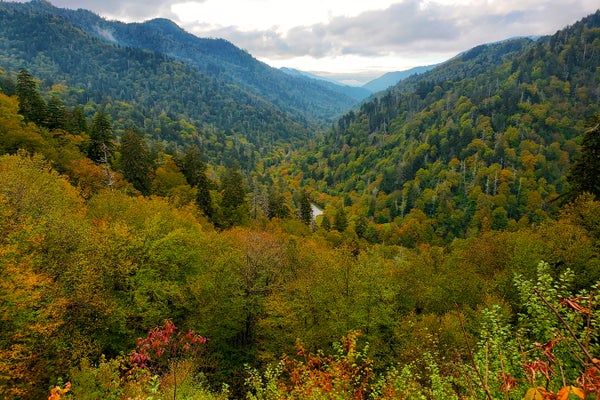CLIMATEWIRE | The endangered forest at the heart of America’s most biologically diverse national park has made a modest recovery in recent decades, thanks to curbs on overlogging and acid rain.
But climate change means the iconic spruces and firs of Great Smoky Mountains National Park aren’t out of the woods yet. The National Park Service released inventory data in January that found that the park’s spruce-fir forest remains in poor condition, despite some improvement. But conservationists remain skeptical the upward trend will continue as warmer winters and invasive species stress the high-altitude trees.
Forests of red spruce and Fraser firs once covered Appalachia from Pennsylvania to Georgia. But logging, acid rain and the introduction of the balsam woolly adelgid — an invasive European insect — put the forests “on the ropes,” Matt Drury, associate director of science and stewardship at the Appalachian Trail Conservancy, told E&E News.
On supporting science journalism
If you're enjoying this article, consider supporting our award-winning journalism by subscribing. By purchasing a subscription you are helping to ensure the future of impactful stories about the discoveries and ideas shaping our world today.
By 1995, the U.S. Fish and Wildlife Service calculated that the southern Appalachian spruce-fir forests had suffered a greater than 98 percent decline since European settlement and classified the forests as America’s second-most endangered ecosystem. Only seven individual forests — known as "stands" — are left in North Carolina, Tennessee and Virginia. Great Smoky Mountains National Park on the Tennessee-North Carolina border is home to the largest surviving stand in southern Appalachia.
Great Smoky is also the most visited national park.
Spruce-fir forests have recovered marginally since the 1980s, when about half their habitat was lost to logging and acid rain, and almost all that remained was seriously affected by the adelgid pest. Danika Mosher, a geographic information system specialist at the Forest Service, attributed that to policies controlling logging and reductions in acid rain.
Mosher, who tracks the forest’s condition, said increased precipitation linked to climate change will probably benefit the forests by midcentury.
“But on the flip side, the increase in temperature is also going to be quite drastic,” Mosher added.
The problem is that spruce-fir forests risk running out of habitat.
Under today’s conditions, the forests only thrive at elevations 5,000 feet or more above sea level.
“They're unable to live at lower elevations due to the temperature and different climatic variables,” Drury of the Appalachian Trail Conservancy said. “They are now at the tallest peaks in the southern Appalachians, and there is nowhere higher in elevation for the forest to continue to persist.”
But global warming is expected to gradually push the forests’ habitat to higher elevations, as lower terrain becomes hotter and deciduous trees from lower elevations move in. The mountains that the remaining spruce-fir stands now occupy measure between 5,700 and 6,700 feet high. So experts fear the trees will be squeezed into an ever-smaller range and their numbers will dwindle further.
Rising temperatures are also helping the Fraser firs’ old foe: the balsam woolly adelgid. While feeding on tree sap, the tiny insect injects a substance that cuts off water and nutrient circulation in fir trees, killing them after a couple of years. Drury says the trees “release certain compounds when they're stressed, and that's like a dinner bell to a host of different pests and pathogens,” including the adelgid.
Conservation groups are searching for ways to preserve the spruce. “We don't really know what to do in the face of the balsam woolly adelgid,” Drury said.
But climate change and the adelgid aren’t threatening the trees only. Three endangered species — the Carolina northern flying squirrel, spruce-fir moss spider and rock gnome lichen — “depend on this forest type,” Drury said. “If it went away, there would be an ecological cascade that is tangible — is real. And that can be an extinction event for those species.”
Mosher with the Forest Service says her models indicate the forests will still be around in 2100, “but definitely with impact to its distribution.”
John Caveny, director of conservation and education at the Grandfather Mountain Stewardship Foundation, thinks the spruce-fir stand his foundation oversees in North Carolina will be around for a long time. “We could be talking 250, 300 years if we’re going at the current rate," he said. “But in the grand scheme of how long this species has been here at Grandfather Mountain and been around, that is just a blink.”
Yet Drury is optimistic about conservation efforts in the coming decade after the awarding of an $11 million grant funded by the 2021 bipartisan infrastructure law. In 2023, the Forest Service allocated the funds to restore national forest land in North Carolina and Tennessee — including two spruce-fir stands.
“The gloves are off,” Drury said. “We get all the tools that we need.”
While Caveny believes people will visit Grandfather Mountain regardless of the health of its stand, it adds to the majesty that draws 300,000 visitors to the attraction each year. “The spruce-fir forest is part of what makes us very unique as a mountain and as an ecosystem.”
Steph Jeffries, associate teaching professor in the Department of Forestry and Environmental Resources at North Carolina State University, described the experience of entering a spruce-fir forest. “It smells like the winter holidays. You walk in, and the smell of Fraser fir is really distinctive,” she said. “It’s a visceral experience.”
“They are worthy of our conservation,” Jeffries added. “They're really a special place and very, very limited.”
Caveny remembers guests’ “aha moments” when visiting Grandfather Mountain's southern Appalachian spruce-fir forest for the first time. “Man, this looks like Canada,” they often exclaim.
Reprinted from E&E News with permission from POLITICO, LLC. Copyright 2024. E&E News provides essential news for energy and environment professionals.
